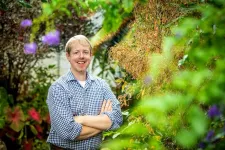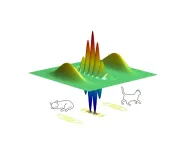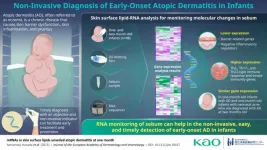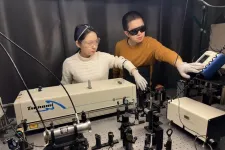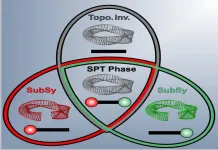(Press-News.org) Philadelphia — Collaborating researchers from the University of Pennsylvania School of Dental Medicine and the Adams School of Dentistry and Gillings School of Global Public Health at the University of North Carolina have discovered that a bacterial species called Selenomonas sputigena can have a major role in causing tooth decay.
Scientists have long considered another bacterial species, the plaque-forming, acid-making Streptococcus mutans, as the principal cause of tooth decay—also known as dental caries. However, in the study, which appeared 22 May in Nature Communications, the Penn Dental Medicine and UNC researchers showed that S. sputigena, previously associated only with gum disease, can work as a key partner of S. mutans, greatly enhancing its cavity-making power.
“This was an unexpected finding that gives us new insights into the development of caries, highlights potential future targets for cavity prevention, and reveals novel mechanisms of bacterial biofilm formation that may be relevant in other clinical contexts,” said study co-senior author Hyun (Michel) Koo DDS, PhD, a professor in the Department of Orthodontics and Divisions of Pediatrics and Community Oral Health and Co-Director of the Center for Innovation & Precision Dentistry at Penn Dental Medicine.
The other two co-senior authors of the study were Kimon Divaris, PhD, DDS, professor at UNC’s Adams School of Dentistry, and Di Wu, PhD, associate professor at the Adams School and at the UNC Gillings School of Global Public Health.
“This was a perfect example of collaborative science that couldn’t have been done without the complementary expertise of many groups and individual investigators and trainees,” Divaris said.
Caries is considered the most common chronic disease in children and adults in the U.S. and worldwide. It arises when S. mutans and other acid-making bacteria are insufficiently removed by teeth-brushing and other oral care methods, and end up forming a protective biofilm, or “plaque,” on teeth. Within plaque, these bacteria consume sugars from drinks or food, converting them to acids. If the plaque is left in place for too long, these acids start to erode the enamel of affected teeth, in time creating cavities.
Scientists in past studies of plaque bacterial contents have identified a variety of other species in addition to S. mutans. These include species of Selenomonas, an “anaerobic,” non oxygen-requiring group of bacteria that are more commonly found beneath the gum in cases of gum disease. But the new study is the first to identify a cavity-causing role for a specific Selenomonas species.
The UNC researchers took samples of plaque from the teeth of 300 children aged 3-5 years, half of whom had caries, and, with key assistance from Koo’s laboratory, analyzed the samples using an array of advanced tests. The tests included sequencing of bacterial gene activity in the samples, analyses of the biological pathways implied by this bacterial activity, and even direct microscopic imaging. The researchers then validated their findings on a further set of 116 plaque samples from 3 to 5-year-olds.
The data showed that although S. sputigena is only one of several caries-linked bacterial species in plaque besides S. mutans, and does not cause caries on its own, it has a striking ability to partner with S. mutans to boost the caries process.
S. mutans is known to use available sugar to build sticky constructions called glucans that are part of the protective plaque environment. The researchers observed that S. sputigena, which possesses small appendages allowing it to move across surfaces, can become trapped by these glucans. Once trapped, S. sputigena proliferates rapidly, using its own cells to make honeycomb-shaped “superstructures” that encapsulate and protect S. mutans. The result of this unexpected partnership, as the researchers showed using animal models, is a greatly increased and concentrated production of acid, which significantly worsens caries severity.
The findings, Koo said, show a more complex microbial interaction than was thought to occur, and provide a better understanding of how childhood cavities develop—an understanding that could lead to better ways of preventing cavities.
“Disrupting these protective S. sputigena superstructures using specific enzymes or more precise and effective methods of tooth-brushing could be one approach,” Koo said.
The researchers now plan to study in more detail how this anaerobic motile bacterium ends up in the aerobic environment of the tooth surface.
“This phenomenon in which a bacterium from one type of environment moves into a new environment and interacts with the bacteria living there, building these remarkable superstructures, should be of broad interest to microbiologists,” Koo said.
“Selenomonas sputigena acts as a pathobiont mediating spatial structure and biofilm virulence in early childhood caries” was co-authored by Hunyong Cho, Zhi Ren, Kimon Divaris, Jeffrey Roach, Bridget Lin, Chuwen Liu, M. Andrea Azcarate-Peril, Miguel Simancas-Pallares, Poojan Shrestha, Alena Orlenko, Jeannie Ginnis, Kari North, Andrea Ferreira Zandona, Apoena Aguiar Ribeiro, Di Wu and Hyun “Michel” Koo.
The work was funded in part by the National Institutes of Health (U01DE025046, R01DE025220, R03DE028983).
END
Penn Dental Medicine collaboration identifies new bacterial species involved in tooth decay
Large study in children reveals Selenomonas sputigena as a key partner of Streptococcus in cavity formation.
2023-06-08
ELSE PRESS RELEASES FROM THIS DATE:
Team finds reliable predictor of plant species persistence, coexistence
2023-06-08
CHAMPAIGN, Ill. — Like many ecological scientists, University of Illinois Urbana-Champaign plant biology professor James O’Dwyer has spent much of his career searching for ways to measure and predict how specific plant communities will fare over time. Which species in a diverse population will persist and coexist? Which will decline? What factors might contribute to continuing biodiversity?
In a new study reported in the journal Nature, O’Dwyer and his colleague, U. of I. graduate student Kenneth Jops, report the development of a method for determining ...
Scientific Symposium - Improving pediatric cancer care by scientific excellence - Princess Máxima Center for pediatric oncology - Utrecht, the Netherlands
2023-06-08
The Princess Máxima Center's Board of Directors, Research management and the clinical directors warmly invite you to attend our interdisciplinary symposium, to celebrate the first five years existence of the Princess Máxima Center for Pediatric Oncology.
This 2-day Scientific Symposium will take place on June 12th and 13th 2023 in the Jaarbeurs in Utrecht. There will be presentations from well-known speakers covering the various disciplines within the field of pediatric oncology and beyond, showcasing latest developments and technologies.
This event will create ...
Connecting the dots: Leveraging information to improve the nation’s public health
2023-06-08
INDIANAPOLIS – The pandemic has placed a spotlight on public health -- its workforce, infrastructure and underlying information systems designed to collect, analyze and manage public health data.
Informatics, health information technology and public health experts from across the nation convened at an American College of Medical Informatics symposium concluded that how information is received and shared by public health agencies is overdue for “a strategically designed, technology-enabled, information infrastructure for delivering day-to-day essential public health services and to respond effectively to ...
Schrödinger’s cat makes better qubits
2023-06-08
Quantum computing uses the principles of quantum mechanics to encode and elaborate data, meaning that it could one day solve computational problems that are intractable with current computers. While the latter work with bits, which represent either a 0 or a 1, quantum computers use quantum bits, or qubits – the fundamental units of quantum information.
“With applications ranging from drug discovery to optimization and simulations of complex biological systems and materials, quantum computing has the potential to reshape vast areas of science, industry, and society,” says ...
A novel way to diagnose early-onset atopic dermatitis using sebum
2023-06-08
Eczema is an inflammatory skin condition that often affects infants as young as one to two months. Among the various types of eczema seen in infants, early-onset atopic dermatitis (AD), characterized by psychological stress and sleep disorders, is particularly concerning. Studies have, in fact, identified that if left untreated, AD can increase the risk of allergic diseases such as food allergies and asthma—a progression also known as the “atopic march”. Early diagnosis and intervention of early-onset AD is needed to ensure the infant’s psychological and physical ...
Aviation turbulence strengthened as the world warmed — study
2023-06-08
The skies aircraft fly through are bumpier today than four decades ago, scientists have found, after producing a new analysis showing that turbulence has increased as the climate changed.
New research from the University of Reading shows that clear-air turbulence, which is invisible and hazardous to aircraft, has increased in various regions around the world.
At a typical point over the North Atlantic – one of the world’s busiest flight routes – the total ...
Giving parents better school quality data encourages them to consider less affluent, less white schools -- To a Point
2023-06-08
Washington, June 8, 2023—For years, parents looking for data to compare the academic quality of schools for their children had one primary measure to turn to: average student scores on standardized tests. However, these scores are often related to factors that have nothing to do with instructional quality—such as family income or racial and ethnic background—and push parents toward schools that are Whiter and more affluent, exacerbating school segregation in the U.S. As a result, many education ...
UMass Amherst epidemiologist updates and validates ‘gold standard’ of prenatal physical activity tools
2023-06-08
A University of Massachusetts Amherst public health researcher has updated and validated the widely used Pregnancy Physical Activity Questionnaire (PPAQ) to improve the measurement performance of this self-report physical activity method.
Lisa Chasan-Taber, professor and chair of biostatistics and epidemiology, and her research group used novel and innovative tools – an advanced accelerometer and wearable camera – to assess PPAQ performance. The researchers developed the PPAQ in 2004 as the first validated pregnancy physical activity questionnaire. Listed on the UMass Amherst timeline ...
Researchers tune thermal conductivity of materials ‘on the fly’ for more energy-efficient devices
2023-06-08
A team led by University of Minnesota Twin Cities scientists and engineers discovered a new method for tuning the thermal conductivity of materials to control heat flow ”on the fly.” Their tuning range is the highest ever recorded among one-step processes in the field, and will open a door to developing more energy-efficient and durable electronic devices.
The researchers’ paper is published in Nature Communications, a peer-reviewed scientific journal covering the natural sciences.
Just as electrical ...
Topological phase protection reams to sub-symmetry
2023-06-08
An international team led by researchers at Nankai University in China and at University of Zagreb in Croatia, along with team at the Institut national de la recherche scientifique (INRS) in Canada, led by Roberto Morandotti has made an important breakthrough in the study of topological phases. Their findings were recently published in Nature Physics – a journal published by Nature Publishing Group.
In the last decade, topological photonics has attracted increasing attention due to the unique prospects to achieve light manipulation with high performance in terms of robustness and stability. Discoveries in topological photonics ...
LAST 30 PRESS RELEASES:
Do our body clocks influence our risk of dementia?
Anthropologists offer new evidence of bipedalism in long-debated fossil discovery
Safer receipt paper from wood
Dosage-sensitive genes suggest no whole-genome duplications in ancestral angiosperm
First ancient human herpesvirus genomes document their deep history with humans
Why Some Bacteria Survive Antibiotics and How to Stop Them - New study reveals that bacteria can survive antibiotic treatment through two fundamentally different “shutdown modes”
UCLA study links scar healing to dangerous placenta condition
CHANGE-seq-BE finds off-target changes in the genome from base editors
The Journal of Nuclear Medicine Ahead-of-Print Tip Sheet: January 2, 2026
Delayed or absent first dose of measles, mumps, and rubella vaccination
Trends in US preterm birth rates by household income and race and ethnicity
Study identifies potential biomarker linked to progression and brain inflammation in multiple sclerosis
Many mothers in Norway do not show up for postnatal check-ups
Researchers want to find out why quick clay is so unstable
Superradiant spins show teamwork at the quantum scale
Cleveland Clinic Research links tumor bacteria to immunotherapy resistance in head and neck cancer
First Editorial of 2026: Resisting AI slop
Joint ground- and space-based observations reveal Saturn-mass rogue planet
Inheritable genetic variant offers protection against blood cancer risk and progression
Pigs settled Pacific islands alongside early human voyagers
A Coral reef’s daily pulse reshapes microbes in surrounding waters
EAST Tokamak experiments exceed plasma density limit, offering new approach to fusion ignition
Groundbreaking discovery reveals Africa’s oldest cremation pyre and complex ritual practices
First breathing ‘lung-on-chip’ developed using genetically identical cells
How people moved pigs across the Pacific
Interaction of climate change and human activity and its impact on plant diversity in Qinghai-Tibet plateau
From addressing uncertainty to national strategy: an interpretation of Professor Lim Siong Guan’s views
Clinical trials on AI language model use in digestive healthcare
Scientists improve robotic visual–inertial trajectory localization accuracy using cross-modal interaction and selection techniques
Correlation between cancer cachexia and immune-related adverse events in HCC
[Press-News.org] Penn Dental Medicine collaboration identifies new bacterial species involved in tooth decayLarge study in children reveals Selenomonas sputigena as a key partner of Streptococcus in cavity formation.

